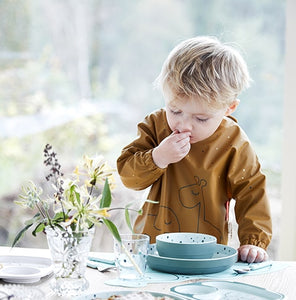The Swan Label is still fully engaged in their campaign “Your choice today means everything tomorrow”, which basically focuses on improving the environment. And since we at Mammashop support this, we thought we would also promote a healthier everyday life and give you some good tips on how to create the best conditions for a healthy indoor climate in the children's room.
However, we are still completely convinced that a children's room should be just as nice and safe as it should be healthy. Therefore, these tips fortunately do not change that and are also very easy to follow
1: Toys
If you have toys from before 2007, it is recommended that you dispose of them. They may contain phthalates, which in the long run can be hormone-disrupting for your child. These hormone disruptions can, among other things, lead to fertility problems, type 2 diabetes, behavioral issues, obesity, and in the worst case, increase the risk of hormone-related cancers.
If you are looking for toys that are neither dangerous for your child nor the environment, a brand like PlanToys would be a good choice. PlanToys is sustainable wooden toys, where the focus is that their raw materials should be free from chemicals and as pure as possible. Therefore, they also use chemical-free glue and organic paint.
But regardless of phthalates or not, one thing is certain: children have a lot of toys! And it often takes up (or clutters, if you will ) a lot of space when in use. Therefore, it can be a good idea to store various stuffed animals and dolls in boxes. This way, everything is organized, it looks tidy, and you avoid dust collecting on them. Win win!
2: Useful decorative plants
One thing that can greatly help improve the indoor climate is plants. All plants convert carbon dioxide into oxygen, but only some plants are particularly air-purifying. These often come from tropical and subtropical regions and could be, for example, the butterfly palm, golden pothos, or mother-in-law's tongue
But even though plants are both useful and particularly decorative in the room, soil, children, and small fingers are not always the best combination. Therefore, place the plants at a height where little fingers cannot reach them. Or opt for plants that can be hung up.
3: Let new things off-gas
If you have just bought (or are about to buy) a larger bed for the child or an extra dresser for all the toys, you should be aware of the content of chemical substances. Many newly produced furniture emits a range of toxic chemicals that are not good for your child's – or anyone else's – indoor climate.
Therefore, it is recommended that you let your new furniture "off-gas" outside or in a well-ventilated room for about a week. If you live in a place where it is not possible to off-gas it – for example, in an apartment – it would be a good idea to dust often and thoroughly and also air out every day.
If you want to ensure that these chemical substances are not found in your furniture, you should look for products with labels such as those from Hoppekids. Their bed systems are the only ones in the world with the Swan Label.
Read more about Swan-labeled furniture from Hoppekids here!
4: Three daily ventilations
With three daily ventilations (with cross-ventilation), you can significantly improve the indoor climate. You not only minimize the number of particles in the room and the humidity, but you also help create a healthy CO2 level. When during the day you want to ventilate is entirely up to you, but it is recommended to ventilate just before bedtime, as fresh air increases the chance of better sleep. And who doesn't love it when the little one falls asleep quickly?
However, the daily ventilations are not of much use if you have the door open to the room while cooking and using a fireplace (e.g., candles and wood stove), which emit particles. So remember to close it!
5: Humid environments
After your child has hopefully had a good night's sleep, the room's indoor climate may feel a bit humid – especially under the duvet, where the warmth has been trapped. If you make the bed immediately – thus keeping in the warmth and humidity – there is a chance that dust mites will come. They thrive very well under humid duvets. However, they are quite harmless – but not very nice to think about
So instead of making the bed, you should shake the duvet and pillows and place them at the foot of the bed and ventilate well.
The reason why humidity increases is partly because we humans actually sweat about 2 dl of water at night. Therefore, for hygiene reasons, it would be good to wash the bedding every 14 days at a minimum of 60 degrees.
Just like with toys, environmentally friendly bedding and other textiles are also produced. Several products from, among others, Sebra, Müsli and Filibabba are GOTS certified (Global Organic Textile Standard), which is the most widely used certification for organic textiles.






















































































































































